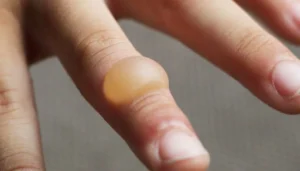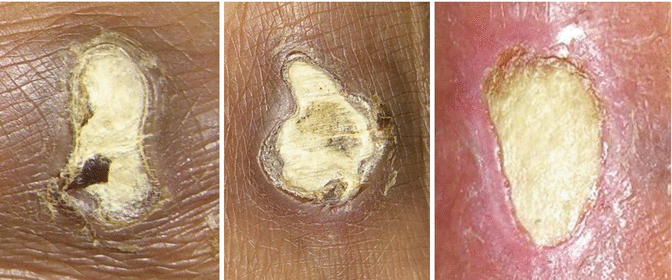Let’s assume you are at a burn scenario, and you might either be the victim or an observer who has witnessed someone else suffering from a burn. In such a situation, here’s what you need to do.
First, you will determine what caused the burn.

What is the Reason of Burn?
The approach to treating the burn heavily depends on its cause. You need to assess whether the burn was caused by a hot object like metal, iron, or hot utensils.
1. Was the burn caused directly by fire?
2. Was the burn caused by hot liquids such as milk, boiling water, or oil, which are also known as scalds?
3. Is the burn due to a chemical or an electric shock?
After identifying the cause of the burn, it’s crucial to find the appropriate treatment for it.
If You are a Victim of Fire
Let’s say the burn was caused by fire.
1. Get away from the Source but don’t Run.
Firstly, we need to move away from the fire. Keep in mind not to run hastily, as running can cause the fire to flare up more intensely and spread.
2. Roll on the Ground
Once you are away from the fire, check if your clothes have caught fire? If they are on fire, immediately roll on the ground until the fire is extinguished.
3. Remove Clothes
Afterwards, remove the clothing that has caught fire.
4. Reach Ventilated Place
Run away from the source and reach a place with ventilation.
Being Observer What Can you Do?
If you see someone catching fire and need to assist, first ensure that the scene is safe. You should avoid putting yourself in danger while trying to help.
1. Use a Fire Extinguisher
You can use a fire extinguisher to douse the flames.
2. Use a Wet Blanket
Alternatively, a wet blanket can also be used to extinguish the fire if someone’s clothes have caught fire. Wrapping the victim in the blanket will cut off the oxygen supply and smother the flames.
3. Roll on the Ground
If neither of these options is available, advise the victim to continuously roll on the ground until the fire on their clothing is completely extinguished.
4. Move to a Wet, Ventilated Area
Then, leave the smoke-filled area or room.
Remember, most fatalities in fires are not due to burns but due to smoke inhalation.
Smoke emits a highly poisonous gas known as carbon monoxide. Inhaling this gas can be deadly.
So, it’s important to remember that after escaping the fire, you should also get away from any smoke-filled areas and move to an open or ventilated space.
Burn by Chemicals
If the burn is caused by a chemical, what should you do?
You should pour a large amount of water over the area to dilute the chemical.
Burn by Electricity
If the burn is caused by an electric current or shock, remember not to touch the victim with bare hands or bare feet, as this could lead to you getting electric shocked.
Wear rubber slippers or shoes on your feet, and use gloves, plastic, or wood to move the victim away from the electric current.
Rubber, plastic, and dry wood do not conduct electrical current, so you won’t get an electric shock.
Always remember to take a victim of an electrical burn to the hospital immediately.
This is because an electric shock flows through the body, affecting the heart, which has a high blood volume. And since blood is a good conductor of electricity, it facilitates the flow of electrical current.

First Aid for Burnt Area
In cases of burns, here’s the first aid to provide:
1. Keep the burned area under cool running water for 10-20 minutes.
This reduces swelling at the burn site, decreases pain, and cleans the area. It also helps to reduce inflammation.
Note: Use only soft running water or cool water. Never use ice or ice-cold water, as it can deepen the injury.
2. If you are wearing any jewelry, remove it immediately. This could be rings, chains, belts, or even a diaper for a small child. Once swelling sets in, it can become difficult to remove the jewelry.
3. Do not apply any type of paste such as toothpaste, turmeric, mashed potatoes, honey, ghee, cream, moisturizer, etc., to the burn area.
After a burn, the area becomes more prone to infection. Therefore, avoid using any home remedies.
4. What you can apply on the burn area? You can use an antibiotic ointment.
You can leave the area open after applying the ointment.
However, if the area is rubbing against clothing, you can cover it with a clean, sterile bandage. Remember not to use any cotton.
5. If someone has extensive burns on their body, never leave them in a cold place, as this can cause heat loss from their body. This could lead to hypothermia, which is a risk.
Don’t Burst Blisters
The area affected by the burn will begin to swell, redden, develop sores, and possibly blisters. It’s important not to pop these water-filled blisters; instead, leave them intact. If they open on their own, gently clean the area with running water.

If you’re experiencing significant pain due to a severe burn, oral painkillers may be taken for relief.
Superficial burns, which only impact the outermost layer of skin, are often more painful and generally take about a week to heal.
On the other hand, deeper burns that reach the underlying flesh tend to be less painful but require three to four weeks to heal fully.
When to Rush to doctor
In which cases should we take a patient to the doctor?
For this purpose, we can categorize burns into two types:
1. Major burn
2. Minor burn
If the area of the burn is larger than the size of a palm, we classify it as a major burn and it necessitates a visit to the doctor.
Additionally, if a child has been burned, or if the burn is on the genital area, facial area, is caused by chemicals or electricity, or if you have been exposed to smoke for an extended period, you should seek medical attention.
Also, if there is a white eschar formed on the burn, it is important to visit the doctor.

Preventive Measure against Burns
Since children are particularly vulnerable to burns, it’s essential to educate them about burns and hot objects.
Here are some precautions:
- Many burns occur due to hot water; therefore, never leave children alone in the bathroom where they might accidentally turn on the hot water tap, which can be dangerous. Always test the water temperature with a finger first.
- Do not take children into the kitchen or areas where hot objects are present.
- After using an iron, place it in a safe area out of children’s reach to cool down.
- Keep hot liquids like tea, coffee, or boiling water away from children.
- Avoid keeping any harmful chemicals that could cause burns at home.
- Cover all electrical outlets to prevent access by children.
Hope this article has improved your understanding about general burn and how to tackle a burn scenario effectively.